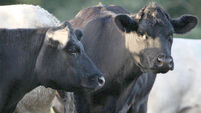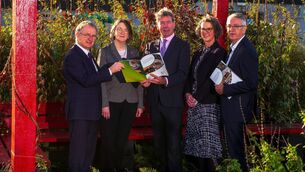Pig farm heat costs up 77% since 2009
The adviser, based at the Oak Park centre in Carlow, said there was concern that fuel costs would become more significant.
A 1,000-sow, integrated pig unit (rearing pigs from birth to slaughter) will spend €80,000 each year on fuel and electricity.
Mr McCutcheon asked: Have you had an energy audit for your farm? How closely is energy use monitored on your farm? What is the energy usage on pig farms?
Recent audits on 23 pig farms have shown a huge variation in energy usage, ranging from 18 up to 45kWh/per pig produced, with an average figure of 28kWh/ per pig produced.
These audits, for 23 farms, included 20,000 sows. The high variation from farm to farm suggests that a greater emphasis should be put on energy efficiency.
Another source of data is 83 pig farms recorded on the Teagasc Pigsys system (2011). The energy cost (heat, power and light) is €3.39 per pig produced (or €81/sow/year, based upon 24 pigs produced/sow/year). This Pigsys data covers 38% of the national pig herd.
Energy on pig farms is mainly used for heating the farrowing and first-stage weaner houses, ventilation systems and fans, lighting throughout the buildings, feed delivery and mixing, power-washing, and manure pumps to mix and agitate slurry tanks.
Mr McCutcheon went into greater detail on the energy cost areas.
Heat must be provided to the younger pigs; the temperature in the farrowing rooms is critical for survival of newly born piglets. The ideal is to have a farrowing room temperature of 24°C, once the first piglet is born in the room. This should be reduced to no more than 20°C when the youngest piglet in the room is over two days old.
Pig producers may use paper to supplement the heat source at farrowing, rather than an infra-red bulb. If the average gestation period is 115 days, it is not necessary to heat up the creep area on day 113 of gestation.
Poor temperature control can lead to unnecessary overheating of heat pads, resulting in wasted heat production and wasted ventilation energy. This applies, particularly, in the first two weeks after farrowing.
First-stage weaners (about 7kg to 17kg liveweight) also require a source of heat. The aim is to have newly weaned pigs kept at 28°C to 29°C, initially, with a reduction of 2°C in room temperature each week, thereafter.
It is critical to check if the ventilation system is working in tandem with the heating system. The ventilation system may control house temperature at a massive cost to the heat-supply system, if the two systems are not working in tandem with each other. A lag time may occur before the temperature sensor shuts off the ‘call’ for heat. This problem can be compounded by the fan cutting in to remove the excess heat. Air quality will be fine, but at a cost to energy usage.
Is there a potential to make cost-effective improvements to reduce heat input? There may be scope to do so if weaning weights have increased. An extra one kilo of body weight at weaning can reduce energy requirement by 8% in this stage of growth. So, weaning heavier pigs will reduce the energy requirement.
Insulation of pig buildings
The provision of heat in buildings is very wasteful, if there is a poor level of insulation. The walls and ceilings should be insulated to achieve suitable u-values. Check the insulation to see if it has been damaged by pests.
The temperature fluctuation in the pig house should also be checked by using maximum-minimum thermometers to monitor if house temperatures vary considerably between day and night.
Heat pumps
A number of units have installed heat-to-air pumps to heat the pads in the farrowing units. These systems extract the heat from ambient air, and use it to heat water via exchange systems. This can be ideal to heat water to temperatures of 55°C.
The capital costs of these systems can be high, but they are effective in reducing fuel costs. A hybrid system also exists, where the heat pumps operate to certain parameters, but if the ambient temperature drops too low, a boiler back-up provides the heat supply. This system links to computerised controls, which can adjust to changing costs of electricity prices, fuel costs, etc, as programmed.
Ventilation Systems and Fans
Pig houses are ventilated to control the levels of gas (carbon dioxide, ammonia, methane and hydrogen sulphide are the main ones) and airborne pathogens in the pigs’ environment. This is to achieve good growth performance in terms of growth rates and feed-conversion efficiencies.
Some pig houses are controlled without the use of mechanical fans to pull fresh air through the house.
This system relies on the ‘stack’ effect, which relies on warm air rising and being replaced by cooler, fresh air from outside the building, and is referred to as natural ventilation.
The only energy used in this system is to control the air inlet and outlets in the building. This system has very low running costs, but may be difficult to manage, particularly in very changeable weather or on very exposed sites.
Ventilation and feeding systems are the main users of energy in the weaner-and-finisher section of a pig farm. If the ventilation system is automatically controlled natural ventilation, and the feeding system is a liquid one, the power usage is greater for the feeding system.
Where the ventilation system is fan-powered with restricted inlets, and the feeding system is an augered wet/dry system, the consumption pattern may be reversed.
Mechanical ventilation relies on fans, air inlets, and controllers to manage the volume of air to be moved through a house. This system has higher running costs because of the use of fans.
Fans are ‘ever ready’ to consume electricity, sometimes with no advantage for improving the pig environment. How often do you see fans at full speed in a dry sow house in mid-winter, or first-stage weaner houses with fans at full speed, and heaters glowing? Remember, when fans are set, either manually or on a curve, they will carry out that function, be it correct or incorrect, until the settings are changed.
When assessing or choosing a fan, the following should be checked, at a minimum:
*Fan size must be matched to the stock type (weaners, finishers etc.) and to the numbers accommodated in the pig house to be ventilated. Will the fans move adequate air to keep the air in the pig house fresh?
* Inlet size versus fan capacity: is there a risk of over-ventilating the room, thereby chilling pigs and wasting energy?
* Fan efficiency: how much air is moved by the fan, versus the power required by the fan? You need to check the data sheet provided by the manufacturer to get this information.
* The ‘back pressure’ is the resistance to air flow at the fan outlet. This needs to be factored into the equation also, to determine fan efficiency.
Natural Power Ventilation
This is a new system designed to work as a naturally ventilated house, when possible. It could be described as an adaptation of the natural system with the ability to mechanically ventilate, when necessary.
Extra air outlets are installed to allow the natural ventilation system to operate. When there is a need for additional ventilation, the fans begin to operate.
This system may have a higher initial capital cost, but was achieving a reduction in electricity usage for ventilation of about 80% for finishing houses, where it was monitored on three farms and compared with similar, mechanically ventilated houses. This system did not compare pig performance in the houses; it was assumed that the pigs achieved similar growth performance in each housing system.









